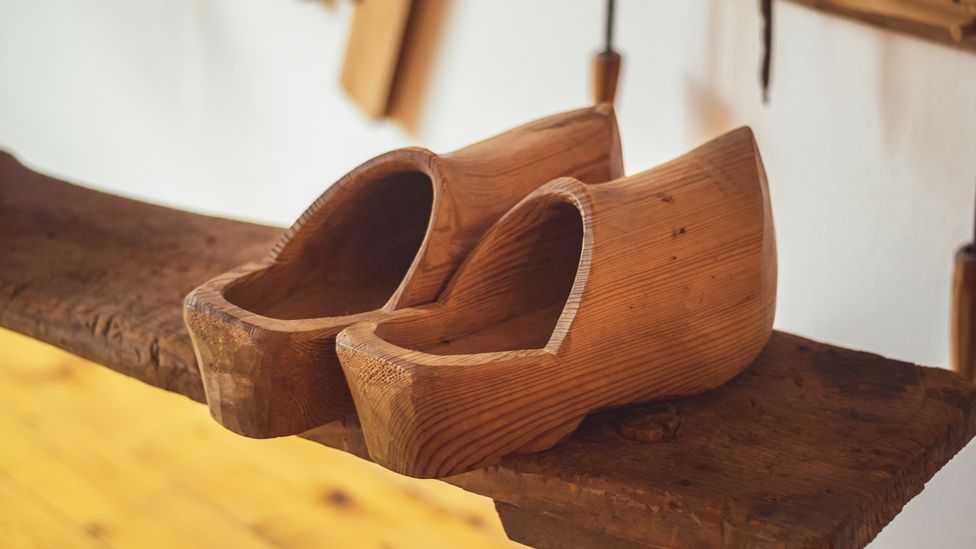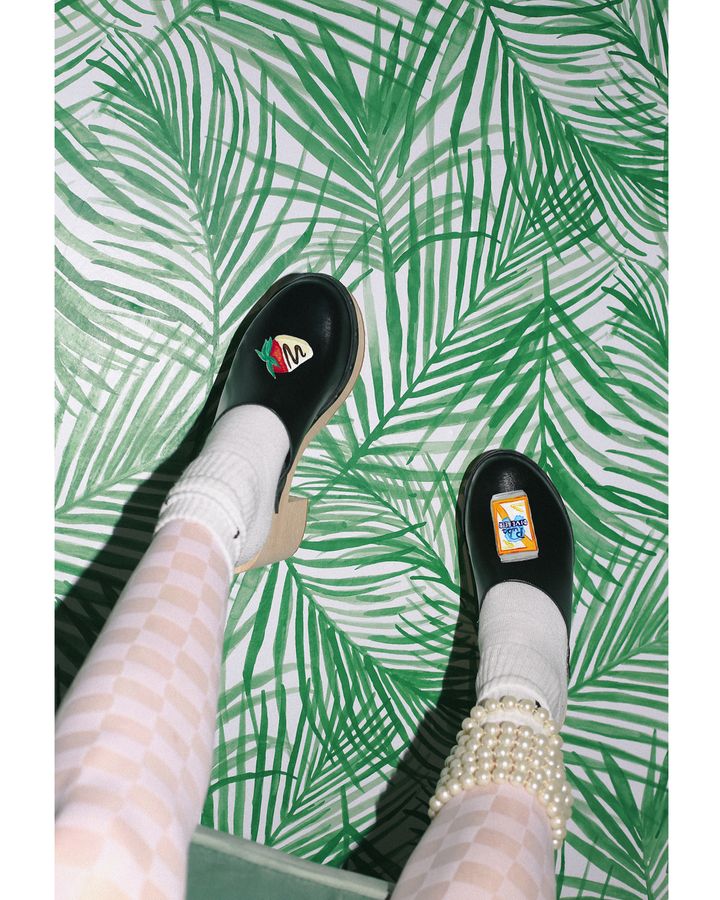From clunky Dutch workwear to a controversial fashion favourite, Daisy Woodward explores why the iconic wooden-soled shoe is a modern icon.
For a long time it was considered one of the most controversial types of shoes in the world. According to his biographer, Beau Brummell, the original dandy and arbiter of men’s fashion in Regency-era England, had an “absolute aversion” to the performance and protective wooden-soled shoe, while Swedish pop sensation ABBA were such ardent fans. that they launched their own line of clogs.
“No clogs, please,” Christian Louboutin begged , style pioneer and clogphobe , on the Fat Mascara podcast in September 2016, days before British designer Christopher Kane unveiled his ground-breaking Spring/Summer 2017 collaboration with Crocs: geodes-encrusted versions of the erstwhile rubber clog. associated with grandmothers’ gardening. Then the creative director of Dior Maria Grazia Curie released Diorquake clogs an ode to the sling beanie of the 1960s, officially kicking off the high fashion renaissance of the 21st century.
The clog is experiencing a 21st-century high fashion renaissance (Credit Getty Images)
Since then, the clog has only grown in popularity: last spring, Hermès released an elegant version of the shoe that it billed as “utility meets sensual pleasure,” which sold out almost instantly. In September 2021 Crocs announced , which is expected to double its sales by 2026. Elsewhere, independent clog brands such as Santa Venetia and No. 6, offer a fresh, stylish take on safety footwear that was once relegated to the realms of agriculture and factory work. , proving its amazing, seemingly endless potential for reimagining.
The exact origins of the clog are unknown – wooden shoes made excellent firewood – but its ancient predecessors include the Roman calcii (boots designed for walking outside) and Japanese Geta (a hybrid of a flip flop and a rising clog). The earliest surviving example of the traditional Dutch clog or clog dates back to early 13th-century Amsterdam, where footwear carved entirely from wood became common among workers as a cheap and effective means of protection and warmth.
By 1570, the first guild of craftsmen was created in Holland clomps , indicating the rise of skilled craftsmen who now made carving shoes from individual blocks of split-resistant wood such as alder, beech and sycamore their profession. By this time, wooden-soled shoes of various shapes were adopted by workers throughout Europe, from the Spanish albarca to French clogs , and remained the most popular type of safety footwear even in the era of the Industrial Revolution. Indeed, there is a possibly apocryphal myth that the term sabotage comes from sabot– sporting French factory workers who either used their discarded clogs to intentionally damage machines or proved to be less efficient than their leather-clad contemporaries, depending on what you believe.
Wooden clogs were an important element of traditional Dutch clothing for both men and women (Image copyright Getty Images)
Clogs arrived in Britain as early as the 1300s, but unlike the all-wooden Dutch versions, they consisted of wooden soles and leather uppers, explains Jeremy Atkinson , the last English manufacturer of traditional clogs. “It’s because the British soil is a lot more abrasive, I think, so the leather came out better.” During the Industrial Revolution, British workers chose clogs because “they were durable, cheaper than shoes and better in both dampness and heat – they absorbed water very well,” Atkinson tells BBC Culture. Their popularity only began to decline in the mid-1800s “when studded boots became more affordable.”
However, clogs could still be found in cotton mills and mines in the 19th century in northern Britain, where they were used as dancing shoes with the appearance of dance on a clog It began among workers who created rhythmic tapping dances with their wooden soles to relieve boredom and dispel the cold, and soon emerged as a popular form of music-hall entertainment, predating tap dancing. (Steppe prodigy Charlie Chaplin began his career as a clog dancer.)
Opting for clogs over more traditional fashion footwear is a sign of self-confidence and aligns with the rise of “ugly” fashion
It wasn’t until the 1960s and 70s that clogs became a widespread fashion. This particular iteration derives from the Swedish clog or träskor , a backless shoe with a wooden sole and a leather upper with a square toe. “They were originally designed as a kind of yard boot that you could pull on with a wool sock to go out to feed the animals and then slip off again,” explains Atkinson.
Clogs were particularly fashionable in the 1970s and now the comfortable, clunky footwear is back in demand (Image: Alamy)
The clogs’ all-natural materials and the fact that they were, at least in part, handmade appealed to the nature-loving nature of the 1960s counterculture. In the 70s, the shoe’s narrow sole and angular silhouette matched perfectly with the decade’s trend for long flowing skirts and flared jeans, prompting brands such as Gucci and MIA to use Swedish-style clogs, which playfully reinterpreted them for the youth-loving the platform .
Since then, the clog has fallen in and out of favor among clothing enthusiasts. The 1990s marked the initial rise of pretty/ugly footwear, particularly clogs, which saw the repurposing of orthopedic footwear as an expression of what Vogue calls “an ironic, aloof, ‘be who you are’ attitude that thumbs its nose at.” at the convention, varnish and glamour”. The 2000s also saw a renewed, if temporary, interest in clogs, when Dutch design duo Viktor and Rolf introduced the traditionally embellished clamps in high heels on the spring-summer 2007 catwalk, and then Karl Lagerfeld presented a high träskor position for Chanel spring-summer 2010. collection three years later.
The return of the clog
However, the current clog craze, which has been steadily gaining momentum since Kane’s collaboration with Croc, seems to have more to do with the full craze of the 1970s – and has spawned a whole series of iterations and reimaginings of the clog. Scandinavian brand Swedish Hasbeens, which launched in 2006 offering classic 70s handmade styles, is enjoying a resurgence. And in the past year, some of fashion’s most influential names have put their own emphasis on footwear, not least Molly Goddard’s maximalist Spring/Summer 2021 collaboration with UGG, which included platform clogs in earth-shattering colors.
Recent fashion favorites include designer Molly Goddard’s platform clog in collaboration with UGG (Image credit: UGG x Molly Goddard)
In October 2021, the global fashion search platform Lyst reported , that searches for clogs were up 124% year-over-year, and searches for wooden clogs, in particular, were up 65% month-over-month. The most coveted styles range from the more practical and affordable – Birkenstock Arizonas and MIA Almas – to high-fashion heeled offerings from Chanel and Dolce & Gabbana.
So, what is it about clogs that appeals to the audience of the 2020s? This is the question BBC Culture put to Lauren Mehling, senior editor and founder of American Vogue @thecloglife, an Instagram account dedicated to all things scoring. “There are several factors converging into the perfect storm of a clog comeback,” she writes in an email, “the first of which is that in our post-#girlboss moment, feminism is not only in fashion, but ingrained in culture like never before “. She explains that for a woman, wearing clogs is a spirit of crime because those who do so “reject the idea that heels, long considered a visually pleasing shoe, are the right thing to do if one wants to look put together.” The same can be said for other gender identities: choosing clogs over traditional fashion shoes is a sign of self-confidence and coincides with growth. ugly »” fashion, 2022’s own Gen-Z punk style brand. Mehling also notes that the pandemic has to some extent gotten rid of uncomfortable shoes that were once an integral part of the work wardrobe – “so more and more latecomers are buying a pair.”
Uncomfortable clogs defeat the very essence of clutter, which is liberation and self-glorification – Laura Mehling
The modern shift towards comfort is undoubtedly an integral factor in the return of the clog – 2021 can be described as the year of comfortable glamor in fashion, adapted to our cautious return from closed life. And clogs, it turns out, are the perfect “transition shoe,” according to Tobias Kleiber, CEO of Scholl Shoes, the shoe brand that invented the calf-tone Scholl Pescura sandal in the 1950s. Like Birkenstock, which debuted with Boston clogs in 1979, and Crocs, which introduced its rubber boat slip-ons in 2001, Scholl has been making clogs continuously since the beginning, and is now riding the wave of a shoe renaissance.
Just as Birkenstock and Crocs recently launched high fashion collaborations with designers such as Valentino Garavarni and Jil Sander (Birkenstock) and Balenciaga’s Demna Gvasalia (Crocs), Scholl recently partnered with Kate Spade and just released a bold new a collection of clogs called Scholl Iconic, reimagining their Pescura clogs and sandals for a 21st century audience. According to Kleiber, this includes plenty of tartan and faux fur, as well as a focus on sustainability – another defining element of the modern appeal of wood-soled shoes. The slogan of the collection is “high comfort”, which, according to the CEO, points to the fact that “fashion and comfort should not be mutually exclusive”.
The recent resurgence of interest in clogs has led to some inventive designs, including Santa Venetia’s collaboration with Panache (Image credit: Santa Venetia)
Santa Venetia x Panache Clogs
This mindset was the driving force behind California-based clog brand Santa Venetia, which launched in 2017. “I’ve always wanted to do clogs, but they just never fit my aesthetic,” co-founder Gemma Greenhill says over the phone, explaining that it was a friend’s pair of 1960s clogs with a fully embroidered upper that swayed her.
It was the shoe that formed the template for the first Santa Venetia design, notes Greenhill, “and since then we’ve been creating somewhat unexpected clogs that are a little different from the usual clogs.” This includes a collaboration with Panache that features hand-painted sushi, fruit, martinis and hot dogs, as well as an elevated take on the rubber-soled nursing clog, a comfortable design that Greenhill notes was the most popular style of 2021. “I think right now people want to have a little fun within the practicality parameter.”
Indeed, Mechling says the only clogs worth investing in are the ones that feel good. Her other top picks include California label Beklina’s ribbed clogs, which she describes as “powerful and feminine,” and New York brand No. 6’s shearling-lined (“foot bath foam”) boots. “Uncomfortable clogs defeat the essence of stuffiness,” she concludes, “which is liberation and self-glorification.”

